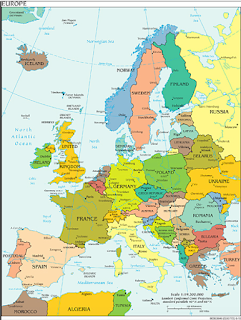Camila Martinica is a senior in Global Studies at The University of Illinois. Camila’s future plans include applying to graduate school. She wrote this blog post in 418 ‘Language and Minorities in Europe’ in spring 2019.
Have you ever been walking down by a beach and noticed the different ways that people communicate with each other? How one group of people can be talking in “American” English while the others speak in “British” English? Or have you noticed how you pick up bits and pieces of a language that you thought you knew, for example Spanish, but in reality what you start hearing is a mixture of two languages and people are just switching from one language, or “code,” to another within the same sentence? This is a phenomenon known as code-switching and I think it makes you feel like you’re in a different world, right?
So, now let me ask you to imagine this:
You’re in North Africa, walking on the Southern coast of the Mediterranean.
You’re at the beach and overhear a Moroccan female in her early 20s say “hua man araf igual que venga o no” which would translate in English to “he, who knows, maybe he comes or he does not come.” This Moroccan female managed to switch from Moroccan Arabic (in bold) to Spanish and was perfectly able to convey her message with the person she was talking to. This is what a linguist named Isabel A. Knoerrich Aldabo observed in her time studying the intricacies of linguistics in Melilla.
At this point, you’re probably searching your mind thinking about whether or not you’ve heard about Melilla or if you could even place it on a map. So, where in the world is it?
 |
| Source: https://commons.wikimedia.org/wiki/File:Spain_CIA_map.png |
As you now know, Melilla is a mélange of different cultures and histories. So, it is reasonable to conclude that language in this autonomous city is just as rich as its history. Melilla is essentially trilingual. The three languages spoken are Castilian, Tarifit and Moroccan Arabic. Tarifit is the Imazighen, or “Berber” language of the Rifian mountains in Morocco (https://www.britannica.com/place/Rif-mountains-Morocco). I think that Melilla is in a special realm when it comes to languages. For people living in Melilla “bilingualism and multilingualism does not mean that all the inhabitants of the enclaves speak two or three languages; it applies almost exclusively to the Moroccan community whose members are exposed to Castilian, which has prestige, since it is the official language of Ceuta and Melilla” (Aldabo, 2011).
So, when it comes to languages, Castilian Spanish is first as it is the official language. Then comes Tamazight, the Berber language, which is not recognized as a co-official language.
I think it’s very hard to wrap my head around how this truly looks on a day-to-day basis, so now imagine this:
You’re in North Africa, walking on the Southern coast of the Mediterranean in an autonomous city of Spain known as Melilla.
You walk into a café farther away from the coast and more towards the west of Melilla, where you start to see Imazighen and Arab influences. At this cafe you can get an authentic Tajine, a traditional Moroccan dish, and talk to a waiter who has Moroccan parents and identifies as Moroccan, but who is a Spanish citizen. The waiter speaks fluent Spanish to you in this formal setting and can tell you all about what it’s like to live under the “four freedoms” of the European Union single-market.
But, this waiter can also speak fluent Moroccan Arabic and when he turns around to place your order, he immediately switches from talking to you, a tourist, in Spanish to a mix between Tamazight and Spanish (think: “hua man arafigual que venga o no” as I mentioned before).
If we think about it, this scenario is extremely peculiar. The logical way it would’ve played out is that the waiter would’ve just kept talking in Spanish and this code-switch for his co-workers would not have been necessary. However, it is very likely that the change came naturally for the waiter. It is what they grew up around. Perhaps they didn’t know a specific word for something you asked for in Spanish but knew it in Tamazight.
On the other hand, this is not usually the case for Spaniards in Melilla. This is in part due to the fact that the Spanish population of Melilla mostly has little to no knowledge of Moroccan Arabic or Tarifit. I believe this is due to the fact that Moroccan Arabic is recently reaching standardization and for centuries has only been passed down orally. This is the intricacy of language in Melilla.
You won’t find many signs in Melilla recognizing the existence of Tamazight or Moroccan Arabic but their presence is strong. Today, the enclaves are in a constant battle of who “claims” them. Whether it is a Moroccan royal visiting Melilla to instigate trouble or Spain ignoring the insults from the Moroccan government of their Prime Minister visiting Ceuta, the tension between cultures is at its peak in Melilla, and I believe that is most evident in their use of languages.
References:
Aldabo, Isabel A.Knoerrich. “When Spain Meets Morocco: Discourses, Language Choices and Linguistic Policy in Ceuta and Melilla.” Dialectologia et Geolinguistica: Journal of the International Society for Dialectology and Geolinguistics, vol. 19, 2011, pp. 103–118. (www.library.illinois.edu/proxy/go.php?url=http://search.ebscohost.com/login.aspx?direct=true&db=mzh&AN=2012901005&site=eds-live&scope=site)
Ceuta, Melilla profile. (2018, December 14). Retrieved from https://www.bbc.com/news/world-africa-14114627
Kirschen, B. (2014). The (Not-So) Distant Relation between Spanish and Arabic. Voices, 2(1). Retrieved from https://escholarship.org/uc/item/6w47k24s





























